This step by step woodworking project is about how to build a 10×12 rectangular pavilion – free diy plans. This wooden pavilion is the perfect addition to you backyard, because it will create shade for an outdoor table and a few chairs. The pavilion can also be built next to a pizza oven / bbq, so you can throw a party with the loved ones. The roof has a 6:12 pitch and it features 2×4 rafters every 16″ on center. This structure is heavy duty, but please follow the building codes and hire a professional contractor if you don’t have the right skills to undertake the project on your own.
We recommend you to invest in the best materials you could afford. Therefore, you should buy weather-resistant lumber, such as pressure-treated lumber, cedar or redwood. If you use regular pine, I recommend you to apply the appropriate products to enhance its durability. Always take accurate measurements before adjusting the size of the components at the proper size. Drill pilot holes trough the components before inserting the wood screws, to prevent the wood from splitting. See all my Premium Plans HERE.
Made from this plan
Pin it for later!
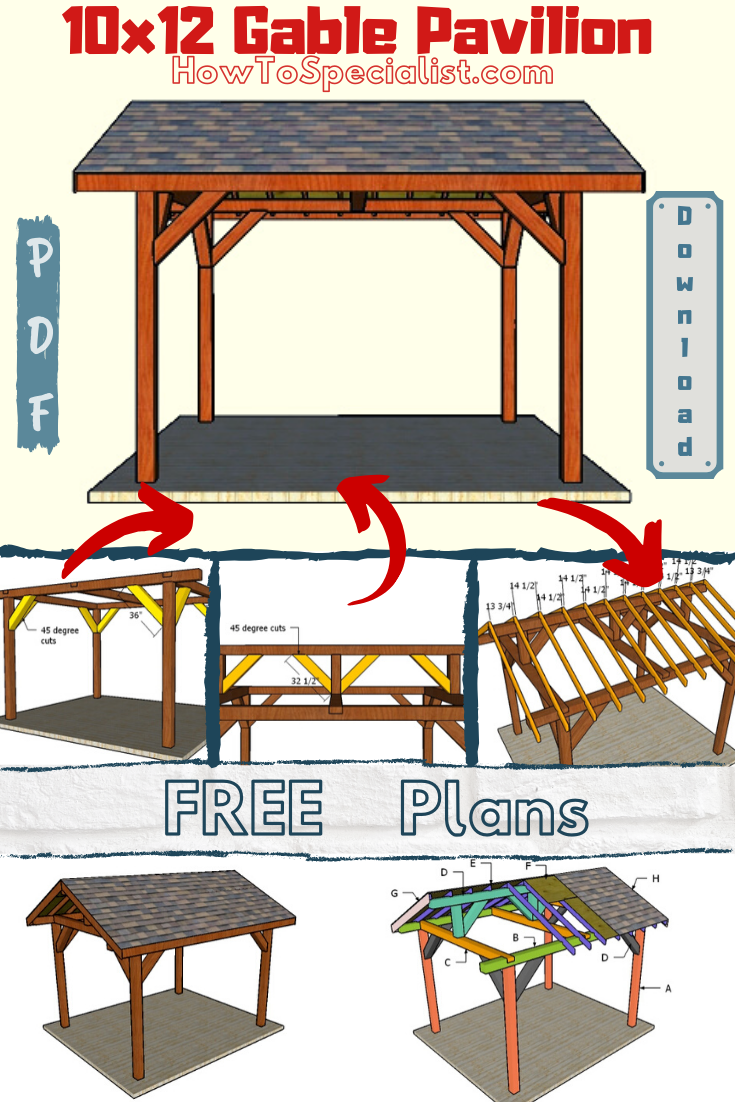
10×12 Pavilion – Free DIY Plans
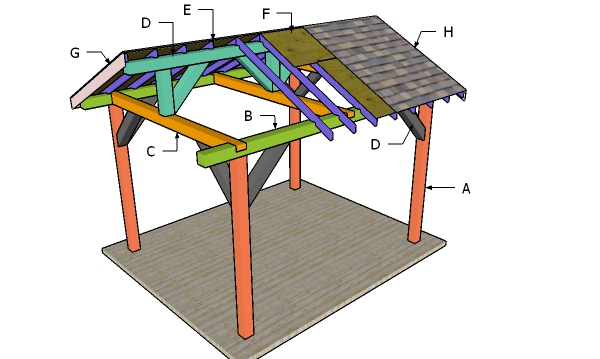
Building a 10×12 pavilion
Materials
- A – 4 pieces of 6×6 lumber – 96″ long POSTS
- B – 2 pieces of 6×6 lumber – 176″ long TOP RAILS
- C – 3 pieces of 6×6 lumber – 120″ long TOP RAILS
- C – 8 pieces of 6×6 lumber – 36″ long BRACES
- D – 3 pieces of 6×6 lumber – 23″ long, 1 piece – 176″ long RIDGE BEAM
- D – 3 pieces of 6×6 lumber – 32 1/2″ long BRACES
- E – 24 pieces of 2×4 lumber – 80″ long RAFTERS
- F – 2 pieces of 1/2″ plywood – 48″x96″ long, 2 pieces – 48″x80″ long, 2 pieces – 30 1/4″x96″ long, 2 pieces – 30 1/4″x80″ long ROOF
- F – 4 pieces of 1×6 lumber – 81 3/4″ long, 2 pieces – 176″ long TRIMS
- H – 225 sq ft of tar paper, 225 sq ft of asphalt shingles ROOFING
- 5 pieces of 6×6 lumber – 8 ft
- 3 pieces of 6×6 lumber – 16 ft
- 3 pieces of 6×6 lumber – 10 ft
- 1 piece of 6×6 lumber – 12 ft
- 24 pieces of 2×4 lumber – 8 ft
- 8 pieces of 1/2″ plywood – 4’x8′
- 4 pieces of 1×6 lumber – 8 ft
- 2 pieces of 1×6 lumber – 16 ft
- 225 sq ft of tar paper, 225 sq ft of asphalt shingles
- concrete form tube
- 4 post anchors
- 24 pieces of 8″ screws
- 20 pieces of 5″ screws
- 100 pieces of 3 1/2″ screws
- wood glue, stain/paint
- 4 pieces of L strong tie
- 6 pieces of post to beam connector
- Screws for Strong ties
- wood glue, stain/paint
Tools
- Safety gloves, glasses
- Miter saw, jigsaw
- Chalk line, tape measure, spirit level, carpentry pencil
- Drill machinery and drill bits
Tips
- Add trims to the pavilion
- Secure the roofing slats to the structure with galvanized screws
Time
- One Week
How to build a 10×12 pavilion
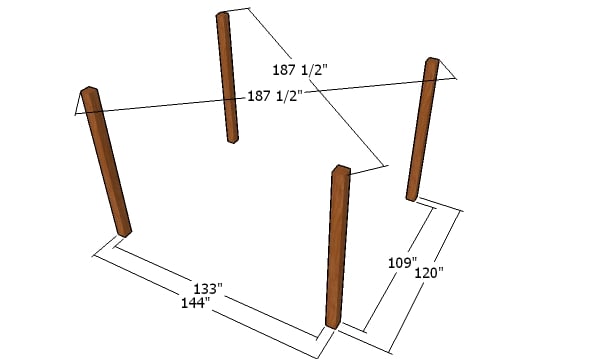
Laying out the posts for the pavilion
The first step of the project is to layout the rectangular pavilion. Therefore, select the location for the pavilion and level the surface with attention. Make sure you remove the vegetation layer and even out the surface. Use batter boards and string to layout the location of the legs. Apply the 3-4-5 rule to each corners, so you make sure they are square. Measure the diagonals and make adjustments so they are equal.

Setting the posts
After marking the location of the posts, you need to dig 3-4′ deep holes in the ground, using a post hole digger. Install tube forms and fit the posts into place, making sure they are perfectly plumb. Secure the anchors before filling the forms with concrete. For this project we will use post anchors, so you don’t need to set the posts into concrete.
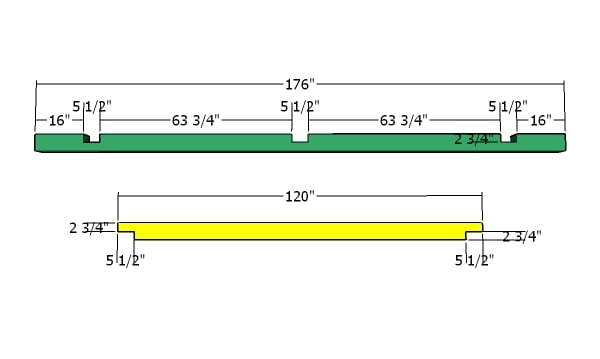
Top plates – small pavilion
Use 6×6 lumber for the top plates. Make notches to the beams, using a circular saw. Make the notches to the plates using a saw and a chisel. Make parallel cuts and then remove the excess with a hammer and a chisel. Smooth the recesses with sandpaper. These cut outs will help you create half lap joints, which makes for a strong and durable way of bonding wood together.

Top plates – pavilion frame
Fit the plates to the sides of the pavilion. Center the plates to the posts, making sure you have 16″ overhangs on both sides. Drill pilot holes and insert 8″ screws to lock them into place. Plumb the posts with a spirit level and check if the top plate is perfectly horizontal. Make sure the corners are square.
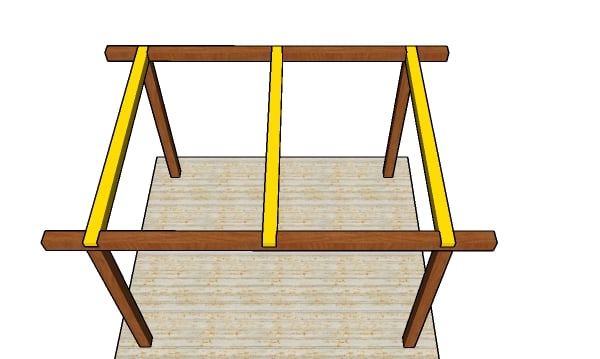
Fitting the cross beams – 10×12 pavilion
Fit the rest of the plates to the top of the pavilion. Drill pilot holes and insert 8″ screws, to assemble everything together tightly.

Fitting the braces
Build corner braces for the pavilion from 6×6 lumber. Make 45 degree cuts to both ends of the braces and then lock them into place tightly with 5″ screws. Plumb the posts and check if the plates are perfectly horizontal. These braces are needed especially if you live in an area with strong winds. They will help with lateral and longitudinal movements.

Ridge beam – 10×12 pavilion
Use 6×6 lumber for the ridge beam and for the supports. Center the supports to the top of the plates and lock them into place with post to beam connectors. Fit the ridge beam to the top of the posts with post to beam connectors. Make sure all corners are square.
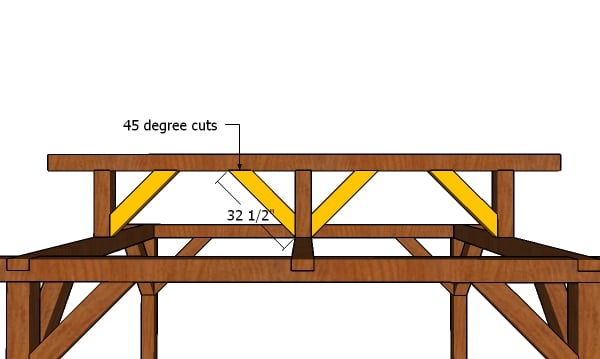
Braces for ridge beam
Use 6×6 lumber for the top ridge braces. Make 45 degree cuts at both ends of the braces and then secure them to the ridge beam. Drill pilot holes and insert 5″ screws to lock them into place.
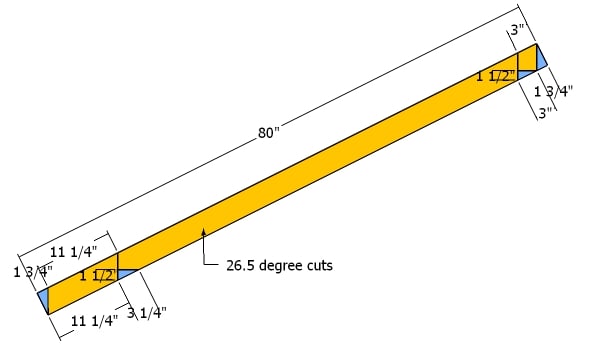
Rafters – 10×12 pavilion
Use 2×4 lumber for the rafters. Make 26.5 degree cuts to both ends of the rafters and then make the birdsmouth cuts, as shown in the diagram. The roof has a 6:12 pitch which corresponds to a 26.4 degree slope.
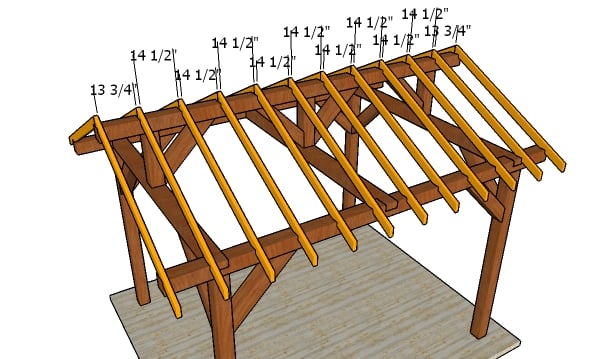
Fitting the rafters – 10×12 pavilion
Fit the rafters to the top of the pavilion. Use the info from the diagram to space the rafters every 16″ on center. The number you see in the plans represents the distance between the rafters. Use rafter ties and 1 1/2″ structural screws to lock the rafters into place tightly.
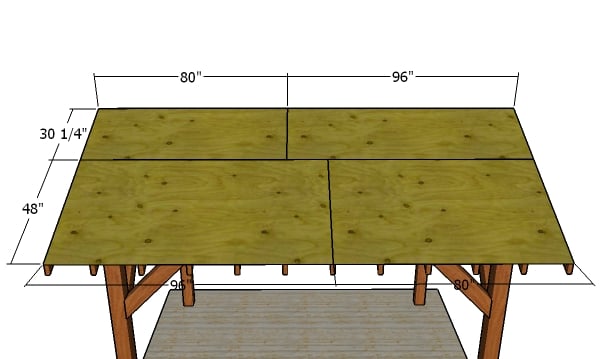
Roof sheets – 10×12 pavilion
Use 1/2″ plywood for the roof sheets. Make cuts to the sheets and lay them on top of the roof structure. Leave no gaps between the sheets and align everything with attention. Drill pilot holes and insert 1 5/8″ screws, every 8″ along the framing.
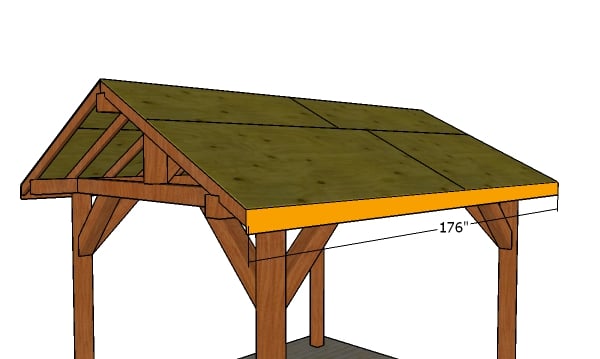
Side roof trims – 10×12 pavilion
Fit the 1×6 trims to the sides of the pavilion. Align the edges flush and insert 6d nails to lock them to the rafters.
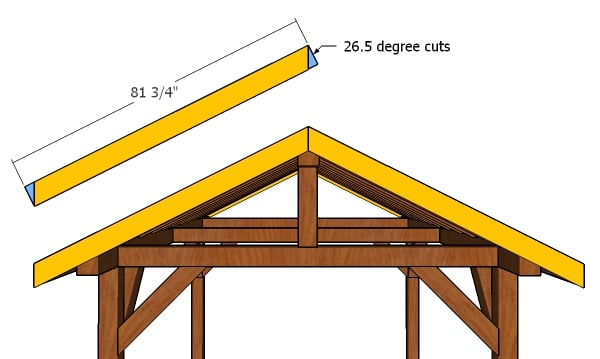
Front and back roof trims
Use 1×6 lumber for the front and back roof trims. Make 26.5 degree cuts to both ends of the trims. Attach the trims to the rafters and insert 2″ nails to lock them into place tightly.
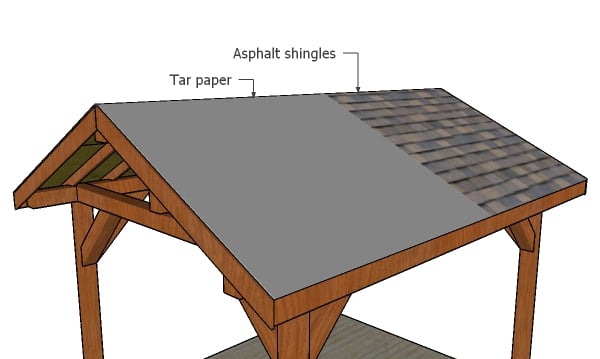
Roofing – 10×12 pavilion
You could fit asphalt shingles to protect the pavilion, as it is a straight forward solution. Therefore, install roofing felt over the roofing sheets, making sure the strips overlap at least 2″. Secure the tar paper to the plywood sheets with roofing staples. Fit the side drip edges over the roofing felt, while the bottom drip edges should be fit under. Place a starting course at the bottom of the roof, before installing the asphalt shingles. Always read the manufacturing instructions before starting the installation, as there are several aspects that differ.
The first course should star with a 3 tab shingle, the second course with a 2 1/2 tab , the third course with a 2 tab, the forth course with a 1 1/2 tab, the fifth course with a 1 tab, the sixth course with a 1/2 tab. Repeat the process from the beginning, starting with the seventh course. Don’t forget that the shingles should overhang from the drip edge about a 1/4″. In addition, secure the asphalt shingles to the roof decking with tacks.
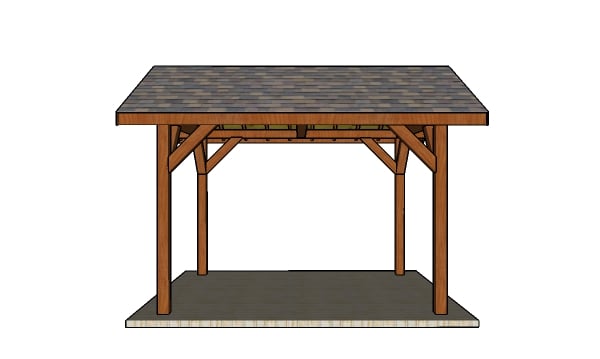
10×12 Pavilion Plans – side view
This is a relatively small pavilion, so you shouldn’t have too much problems with building it by yourself. The design features elegant elements that will match the style of any home. You can add your personal touch to the construction if you want to make it stand out. for example, you can make decorative cuts to the braces and to plates. Moreover, you could replace with plywood sheets with tongue and groove boards.

10×12 Pavilion Plans
You can also adjust the height of the posts. This is an easy technique to personalize the plans. A lower roof will make the pavilion feel more cozy, while using the full 8 ft posts will create a sensation of space and freedom.

10×12 Pavilion Plans – front view
Last but not least, you need to take care of the finishing touches. Therefore, fill the holes with wood putty and then smooth the surface with sandpaper. Apply a few coats of paint or stain over the components to enhance the look of the shed and to protect the components from decay. Since you are here, you might as well take a look over over my screened gazebo palms.
Thank you for reading my project about 10×12 rectangular pavilion plans and we recommend you to check out the rest of the projects. Don’t forget to LIKE and SHARE our projects with your friends, by using the social media widgets. SUBSCRIBE to be the first that gets our latest projects.


7 comments
Free plan
What program are you using to calculate the lumbar dimensions? I would like to build just as you planned above but for a 14 x 14 pavilion. Having the material list the best part of your plans.
I have a 14×14 in the shop. I use Sketchup for 3D modeling.
I have a hard tine finding 6×6 lumber in my area but 4×6 is abundant. Could this pavillion be constructed with 4×6? Thanks!
At your own risk. Read the local codes to see if that is acceptable.
Hello,
similar question to Rob in regards to the 6×6, my question is can 4×6 be used for the top plates, ridge beam & posts?
No